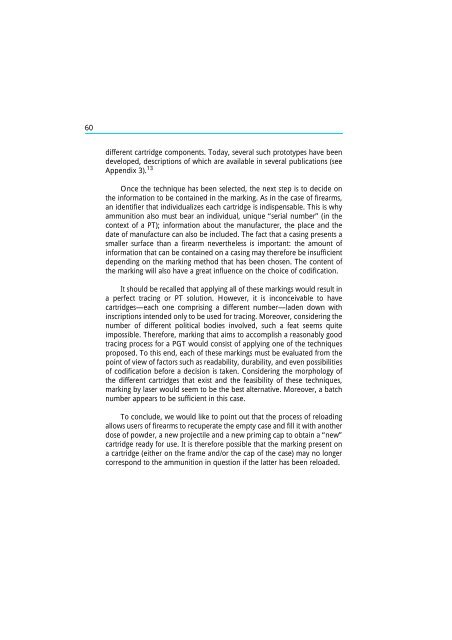The Scope and Implications of a Tracing Mechanism for Small Arms ...
The Scope and Implications of a Tracing Mechanism for Small Arms ...
The Scope and Implications of a Tracing Mechanism for Small Arms ...
Create successful ePaper yourself
Turn your PDF publications into a flip-book with our unique Google optimized e-Paper software.
60<br />
different cartridge components. Today, several such prototypes have been<br />
developed, descriptions <strong>of</strong> which are available in several publications (see<br />
Appendix 3). 13<br />
Once the technique has been selected, the next step is to decide on<br />
the in<strong>for</strong>mation to be contained in the marking. As in the case <strong>of</strong> firearms,<br />
an identifier that individualizes each cartridge is indispensable. This is why<br />
ammunition also must bear an individual, unique “serial number” (in the<br />
context <strong>of</strong> a PT); in<strong>for</strong>mation about the manufacturer, the place <strong>and</strong> the<br />
date <strong>of</strong> manufacture can also be included. <strong>The</strong> fact that a casing presents a<br />
smaller surface than a firearm nevertheless is important: the amount <strong>of</strong><br />
in<strong>for</strong>mation that can be contained on a casing may there<strong>for</strong>e be insufficient<br />
depending on the marking method that has been chosen. <strong>The</strong> content <strong>of</strong><br />
the marking will also have a great influence on the choice <strong>of</strong> codification.<br />
It should be recalled that applying all <strong>of</strong> these markings would result in<br />
a perfect tracing or PT solution. However, it is inconceivable to have<br />
cartridges—each one comprising a different number—laden down with<br />
inscriptions intended only to be used <strong>for</strong> tracing. Moreover, considering the<br />
number <strong>of</strong> different political bodies involved, such a feat seems quite<br />
impossible. <strong>The</strong>re<strong>for</strong>e, marking that aims to accomplish a reasonably good<br />
tracing process <strong>for</strong> a PGT would consist <strong>of</strong> applying one <strong>of</strong> the techniques<br />
proposed. To this end, each <strong>of</strong> these markings must be evaluated from the<br />
point <strong>of</strong> view <strong>of</strong> factors such as readability, durability, <strong>and</strong> even possibilities<br />
<strong>of</strong> codification be<strong>for</strong>e a decision is taken. Considering the morphology <strong>of</strong><br />
the different cartridges that exist <strong>and</strong> the feasibility <strong>of</strong> these techniques,<br />
marking by laser would seem to be the best alternative. Moreover, a batch<br />
number appears to be sufficient in this case.<br />
To conclude, we would like to point out that the process <strong>of</strong> reloading<br />
allows users <strong>of</strong> firearms to recuperate the empty case <strong>and</strong> fill it with another<br />
dose <strong>of</strong> powder, a new projectile <strong>and</strong> a new priming cap to obtain a “new”<br />
cartridge ready <strong>for</strong> use. It is there<strong>for</strong>e possible that the marking present on<br />
a cartridge (either on the frame <strong>and</strong>/or the cap <strong>of</strong> the case) may no longer<br />
correspond to the ammunition in question if the latter has been reloaded.
















